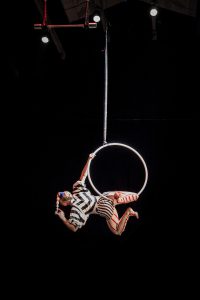There is no shortage of fitness trends out there (think pole fitness, aerial yoga, prancercise…), but there is one that brings a whole new meaning to the phrase “clowning around.” Circus fitness merges functional with fun to create an exciting and engaging new style of workout. The workouts can range from practicing handstands and cartwheels to flying on a trapeze, and everything in between. You can leave your red rubber nose at home though – this type of movement is an art form, and while it’s fun and sometimes silly, it should still be taken seriously!
How It Works
Often affectionately referred to as “clown school,” circus classes are usually held in gymnasiums, warehouses, or big studios with soft floors. Usually you’ll start with a fun but challenging warm up, including some cardio, big arm stretches, hip releases, and overall mobility to prepare for some tough work. Then, at most studios you will move to one of the circus apparatuses:
- Aerial silks: Possibly the most iconic aerial apparatus, silks are a pair of long strips of fabric suspended from a rig on the ceiling. Performers will climb, tie, drop, and twirl in and on them.
- Rope: Much like silks, but not quite as flashy, the rope is a true testimony to strength. Rather than hanging down in a pair like silks, a rope is a single strip of heavyweight, rough canvas. The acrobat uses their feet and sometimes hands to maneuver the rope into dazzling knots, shapes, and drops – similar to silks in visual.
- Sling: Much like a hammock, this is essentially a silk, but in loop form, in which the performer can swing, circle, and do inversions in. This is also commonly transformed into a “strap”, with a small loop to go around the wrist, from which an acrobat can be lifted into the air and suspended by just their arm.

- Trapeze: Another common and iconic apparatus, the “high-flying” trapeze is a bar suspended by ropes that is used to swing, flip, and catch a partner from. Most circus studios don’t have the space to accommodate this act, and the safety net it demands, so instead have the “static” trapeze, which swings much less and is used for solo or partner moves.

Learn how to hang on a hoop hanging from the ceiling. - Tightrope: The tightrope in your circus gymnasium won’t be suspended 20 feet in the air, but it is still difficult to master! Instructors will start you out much closer to the ground, with thicker straps, as you work to greater heights. This helps new performers safely work on their balance and step precision as they practice within their comfort zone.
- Lyra: A lesser-known apparatus, the lyra is a large metal hoop suspended much like a trapeze, in which the performer can swing, spin, hang, and climb.
Functional Fitness
Circus fitness is incredibly unique. It’s not every day that you get to scale ropes or hang from a trapeze, and you’d be hard-pressed to find other exercises that utilize your own bodyweight quite as effectively. Professionals make it look easy, but using your own two arms and legs to climb a slippery piece of silk is no easy task! It requires grip and grit as you realize the only thing between you and a 20 foot fall is your own strength.
Building up that strength is at the heart of circus fitness, which, because of its focus on core stability and making your muscles work together to support you, doubles as functional fitness training. Trainers will usually start and end sessions with working on grip and core strength, as these two things are the keys to strong climbs. They will never send you up higher than you can safely descend, and will allow you to build up strength – and confidence – until you are ready for inversions (or poses in which your heart is higher from the ground than your head).
Is Circus Fitness For You?

Circus arts, much like yoga, pole fitness, or dance, is a creative expression medium that primarily features long, lean bodies. Never fear if that’s not your body type – circus training truly is for every body. Because circus fitness works hard-to-train muscles and increases overall strength, it can have a myriad of benefits for your daily life, including increased core stabilization (which can help with improving posture and alleviating some back pains), greater flexibility, better balance, and general conditioning. You might not be able to climb the silks right away, but while you’re practicing, you’ll work your core, arms, and back, as well as strengthen your hands and your grip strength, which will prepare you for climbing with ease.
If you’ve ever seen Cirque Du Soleil or another professional circus troupe, you might be hesitant to try your hand at circus classes. The beauty of circus training, however, is that it is what you make it. There is something invigorating about trying new, somewhat scary things, and it can leave you feeling empowered, brave, and stronger than ever. If you step out of your comfort zone, you might be surprised at what you find!



